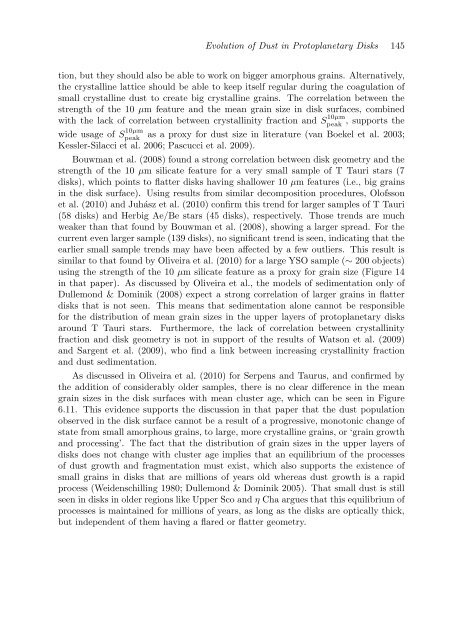Observational Constraints on The Evolution of Dust in ...
Observational Constraints on The Evolution of Dust in ...
Observational Constraints on The Evolution of Dust in ...
You also want an ePaper? Increase the reach of your titles
YUMPU automatically turns print PDFs into web optimized ePapers that Google loves.
Evoluti<strong>on</strong> <strong>of</strong> <strong>Dust</strong> <strong>in</strong> Protoplanetary Disks 145<br />
ti<strong>on</strong>, but they should also be able to work <strong>on</strong> bigger amorphous gra<strong>in</strong>s. Alternatively,<br />
the crystall<strong>in</strong>e lattice should be able to keep itself regular dur<strong>in</strong>g the coagulati<strong>on</strong> <strong>of</strong><br />
small crystall<strong>in</strong>e dust to create big crystall<strong>in</strong>e gra<strong>in</strong>s. <strong>The</strong> correlati<strong>on</strong> between the<br />
strength <strong>of</strong> the 10 µm feature and the mean gra<strong>in</strong> size <strong>in</strong> disk surfaces, comb<strong>in</strong>ed<br />
with the lack <strong>of</strong> correlati<strong>on</strong> between crystall<strong>in</strong>ity fracti<strong>on</strong> and S 10µm<br />
peak<br />
, supports the<br />
wide usage <strong>of</strong> S 10µm<br />
peak<br />
as a proxy for dust size <strong>in</strong> literature (van Boekel et al. 2003;<br />
Kessler-Silacci et al. 2006; Pascucci et al. 2009).<br />
Bouwman et al. (2008) found a str<strong>on</strong>g correlati<strong>on</strong> between disk geometry and the<br />
strength <strong>of</strong> the 10 µm silicate feature for a very small sample <strong>of</strong> T Tauri stars (7<br />
disks), which po<strong>in</strong>ts to flatter disks hav<strong>in</strong>g shallower 10 µm features (i.e., big gra<strong>in</strong>s<br />
<strong>in</strong> the disk surface). Us<strong>in</strong>g results from similar decompositi<strong>on</strong> procedures, Ol<strong>of</strong>ss<strong>on</strong><br />
et al. (2010) and Juhász et al. (2010) c<strong>on</strong>firm this trend for larger samples <strong>of</strong> T Tauri<br />
(58 disks) and Herbig Ae/Be stars (45 disks), respectively. Those trends are much<br />
weaker than that found by Bouwman et al. (2008), show<strong>in</strong>g a larger spread. For the<br />
current even larger sample (139 disks), no significant trend is seen, <strong>in</strong>dicat<strong>in</strong>g that the<br />
earlier small sample trends may have been affected by a few outliers. This result is<br />
similar to that found by Oliveira et al. (2010) for a large YSO sample (∼ 200 objects)<br />
us<strong>in</strong>g the strength <strong>of</strong> the 10 µm silicate feature as a proxy for gra<strong>in</strong> size (Figure 14<br />
<strong>in</strong> that paper). As discussed by Oliveira et al., the models <strong>of</strong> sedimentati<strong>on</strong> <strong>on</strong>ly <strong>of</strong><br />
Dullem<strong>on</strong>d & Dom<strong>in</strong>ik (2008) expect a str<strong>on</strong>g correlati<strong>on</strong> <strong>of</strong> larger gra<strong>in</strong>s <strong>in</strong> flatter<br />
disks that is not seen. This means that sedimentati<strong>on</strong> al<strong>on</strong>e cannot be resp<strong>on</strong>sible<br />
for the distributi<strong>on</strong> <strong>of</strong> mean gra<strong>in</strong> sizes <strong>in</strong> the upper layers <strong>of</strong> protoplanetary disks<br />
around T Tauri stars. Furthermore, the lack <strong>of</strong> correlati<strong>on</strong> between crystall<strong>in</strong>ity<br />
fracti<strong>on</strong> and disk geometry is not <strong>in</strong> support <strong>of</strong> the results <strong>of</strong> Wats<strong>on</strong> et al. (2009)<br />
and Sargent et al. (2009), who f<strong>in</strong>d a l<strong>in</strong>k between <strong>in</strong>creas<strong>in</strong>g crystall<strong>in</strong>ity fracti<strong>on</strong><br />
and dust sedimentati<strong>on</strong>.<br />
As discussed <strong>in</strong> Oliveira et al. (2010) for Serpens and Taurus, and c<strong>on</strong>firmed by<br />
the additi<strong>on</strong> <strong>of</strong> c<strong>on</strong>siderably older samples, there is no clear difference <strong>in</strong> the mean<br />
gra<strong>in</strong> sizes <strong>in</strong> the disk surfaces with mean cluster age, which can be seen <strong>in</strong> Figure<br />
6.11. This evidence supports the discussi<strong>on</strong> <strong>in</strong> that paper that the dust populati<strong>on</strong><br />
observed <strong>in</strong> the disk surface cannot be a result <strong>of</strong> a progressive, m<strong>on</strong>ot<strong>on</strong>ic change <strong>of</strong><br />
state from small amorphous gra<strong>in</strong>s, to large, more crystall<strong>in</strong>e gra<strong>in</strong>s, or ‘gra<strong>in</strong> growth<br />
and process<strong>in</strong>g’. <strong>The</strong> fact that the distributi<strong>on</strong> <strong>of</strong> gra<strong>in</strong> sizes <strong>in</strong> the upper layers <strong>of</strong><br />
disks does not change with cluster age implies that an equilibrium <strong>of</strong> the processes<br />
<strong>of</strong> dust growth and fragmentati<strong>on</strong> must exist, which also supports the existence <strong>of</strong><br />
small gra<strong>in</strong>s <strong>in</strong> disks that are milli<strong>on</strong>s <strong>of</strong> years old whereas dust growth is a rapid<br />
process (Weidenschill<strong>in</strong>g 1980; Dullem<strong>on</strong>d & Dom<strong>in</strong>ik 2005). That small dust is still<br />
seen <strong>in</strong> disks <strong>in</strong> older regi<strong>on</strong>s like Upper Sco and η Cha argues that this equilibrium <strong>of</strong><br />
processes is ma<strong>in</strong>ta<strong>in</strong>ed for milli<strong>on</strong>s <strong>of</strong> years, as l<strong>on</strong>g as the disks are optically thick,<br />
but <strong>in</strong>dependent <strong>of</strong> them hav<strong>in</strong>g a flared or flatter geometry.
















